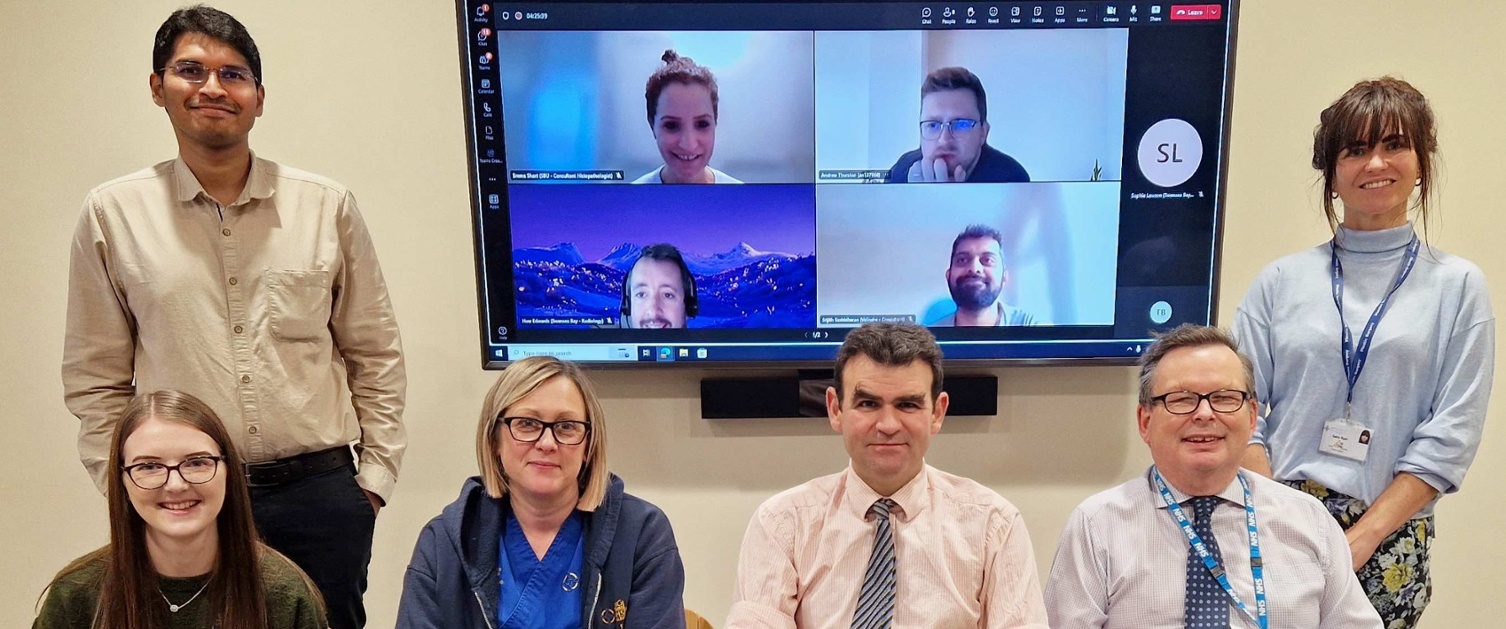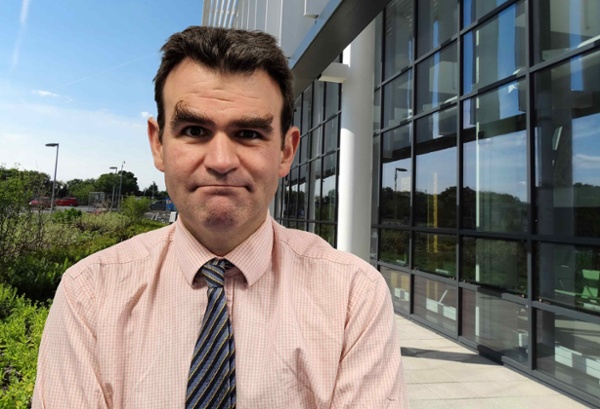Swansea-based cancer service urges people to be vigilant for the tell-tale signs

A dedicated team that treats a relatively rare but highly aggressive type of cancer is urging people to be vigilant for the tell-tale signs.
Sarcoma is an uncommon cancer of the connective tissue of the body such as fat, muscle, nerves, blood vessels and bone. There are many different kinds, which can affect any part of the body.
Historically, though, it can be challenging to diagnose. In fact, many GPs will see only a handful of cases during their professional career.
The real challenge is working out which of the many presenting lumps is possibly malignant.
Fortunately, Wales has a well-structured and well-resourced sarcoma service whose role is to find and treat these worrying lesions.
Main image above. Meet the team… (L-r) Singleton Hospital consultant oncologist Pranab Karipody Prabhakaran; MDT coordinator Sophie Lawson; Sarcoma clinical nurse specialist Hannah Morgan; Thomas Bragg, sarcoma clinical lead; Owen Tilsley, Velindre Hospital consultant oncologist; plastic surgery registrar Daisy Ryan. On-screen, clockwise from top left are: Consultant histopathologist Emma Short; consultant radiologist Andrew Thurston; Velindre consultant oncologist Srijith Sashidharan; consultant radiologist Huw Edwards.
Oncological treatment is delivered in two Welsh cancer centres – Singleton and Velindre.
Some people require specialist surgery, which is undertaken in Swansea, where the South Wales Sarcoma Service multidisciplinary team (MDT) is based. It reviews dozens of cases every week to decide on the best treatment.
Consultant plastic surgeon Thomas Bragg took over as sarcoma lead for ABMU Health Board – Swansea Bay’s predecessor organisation – in 2015.
“The service was not in very good shape for various reasons,” said Mr Bragg. “We have worked hard to evolve the service considerably, and it is now recognised as delivering high quality care in a number of areas.
“We are not shy about confronting challenges, continuing to fight for our patients. If people want to know what best practice looks like for an MDT team, they come here to see ours.
“It’s a service Wales should really be proud of.”
Although based in Swansea, the MDT team can call on the expertise of healthcare professionals across Wales for its weekly case meetings.
And as well as working with professionals within NHS Wales, the MDT also has very close links with a specialist centre in Birmingham where highly specialised surgery for bony and retroperitoneal surgery is undertaken.
Mr Bragg said: “The population of Wales is such that we need to recognise that, for very rare tumour groups, we do not have the number of patients to develop the highly specialist skills that exist in other, high-volume centres.
“The point is that you need people that are doing it regularly, you need MDTs that understand bone oncology and you need to really be doing more than one case every two weeks.
“We manage about 210-220 sarcomas a year. Seven of those might be bony, about 14 might be retroperitoneal. They go to Birmingham.
“I don't think we should be apologising for that because they go to a centre of excellence that is doing these procedures all the time and we want the best outcomes for our patients.
 “Where we can deliver oncological aspects of their care then we do, in Singleton and Velindre. But the spearhead of discussion and MDT management for those cases is in Birmingham and the surgery is too.”
“Where we can deliver oncological aspects of their care then we do, in Singleton and Velindre. But the spearhead of discussion and MDT management for those cases is in Birmingham and the surgery is too.”
But that is for people who have already been diagnosed with sarcoma. Getting to that stage is far from straightforward.
Mr Bragg (right) said the average GP who worked for 40 years might see three sarcomas in their professional career – and often fewer than that.
“What we would like to do is better educate everyone about how to manage and diagnose various lumps and bumps,” he said.
“And I think we just need to sharpen everyone's antennae as to what a potential malignant diagnosis looks like.”
Mr Bragg said the red flag signs were a lump bigger than five centimetres that felt deep, was rapidly growing and might feel painful.
He said sarcomas could be in any part of the body, including the abdomen or head and neck, but were generally more common in the limbs.
Mr Bragg encouraged anyone with a lump they had concerns about to contact their GP, who could refer them for an urgent ultrasound scan.
“The radiologist will define the anatomy, will characterise it, and will ask some clinical questions. Most importantly they will be able to reassure the vast majority of patients,” he said.
"Or where they can't reassure the patient, get them a biopsy or an MRI scan. And then we discuss them as an MDT. Every week we discuss somewhere between 35 and 40 patients.
“Sarcoma is something we need to raise awareness of because while not a particularly prevalent tumour type it is very aggressive.
“As an overall group there is a 52 per cent five-year survival which makes it the fourth most aggressive soft tissue cancer after small cell lung cancer, gastroesophageal cancer and pancreatic.
“So public awareness on this would be a really good thing.”
Swansea Bay consultant radiologist and clinical cancer lead Dr Derrian Markham said: “We are so fortunate in South Wales to have the dedication and expertise of Mr Bragg and his team who deliver excellent and timely care to patients with sarcoma.
“Mr Bragg has worked tirelessly to build up the service since taking over as MDT lead. Under his leadership, the South Wales Sarcoma Service has been centralised in Swansea and collaborates seamlessly with other healthcare teams in Wales to deliver an exceptional regional service.”
Rydym yn croesawu gohebiaeth a galwadau ffôn yn y Gymraeg neu'r Saesneg. Atebir gohebiaeth Gymraeg yn y Gymraeg, ac ni fydd hyn yn arwain at oedi. Mae’r dudalen hon ar gael yn Gymraeg drwy bwyso’r botwm ar y dde ar frig y dudalen.
We welcome correspondence and telephone calls in Welsh or English. Welsh language correspondence will be replied to in Welsh, and this will not lead to a delay. This page is available in Welsh by clicking ‘Cymraeg’ at the top right of this page.